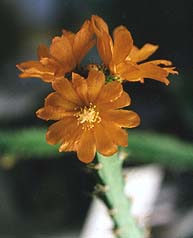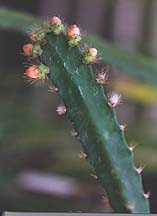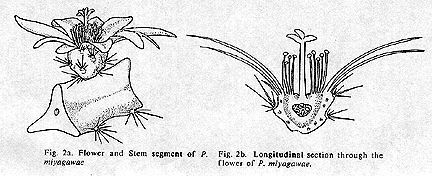 |
 |
Desc from protologue in CSJ (US) p63
1987
Plant - shrubby succulent epiphyte: first
erect, later sprawling-pendent; laterally or basally branching.
Stems - up to 100 cm long, fleshy-soft, 1.5 - 2 cm in diameter;
mostly 3 angled, rarely 4 - 5 angled; only slightly subcrenate.
Areoles - about 1 - 2 cm distant from each other with very
short white wool, up to 10 soft lateral bristles and 3 - 5 whitish
spines up to 7 mm long. |
| Luc Scherens |
Luc Scherens |
Style - 10 mm long, white, with about 6 papillose
white stigma lobes.
Pericarp - about 9 mm in diameter, strongly tuberculate with numerous
bristly areoles. Pericarp wall with abundance of large mucilage cells.
Fruit - whitish, rather small, globose-tuberculate, about 10 mm
in diameter. Numerous areoles with ca. 10 soft spines up to 5 mm long.
about 20 seeds per fruit, 1.7 mm long and 1 mm broad; testa light brown
with convex cells and deeply depressed cell corners (cereoid testa type,
not rhipsaloid)
DISTRIBUTION. This plant is only known from one collection
by Mario Miyagawa on the 19 October 1974 in the yungas of Alto Beni,
near Mataral (between Cochabamba and Santa Cruz, Dept. Cochabamba ,
Bolivia) at 600 m altitude.
The plant grows and flowers easily in cultivation.
This new species is rather unique and has no very close
relatives. Its closest relatives we would consider to be Pfeiffera
ianthothele (Monville) Weber and Acanthorhipsalis (Rhipsalis)
monacantha (Griseb.) Britton and Rose. However, the new species
represents probably the most ancestral type of all rhipsaloid taxa known
resembling in many details even of Erdisia and Corryocactus.
The type locality of Pfeiffera miyagawae by Bauer in Cact Syst. Init.
20:9. 2005
When P. miyagawae was described (Barthlott & Rauh 1987) the quite
large (for the genus) bright orange flowers, produced in abundance in
very early spring, were a little sensation. The type locality, according
to the finder, Mario Miyagawa, was given as: Bolivia; Cochabamba; yungas
of Alto Beni, near Mataral, 600 m. Subsequent collectors have always
failed to find the species at this locality and experienced field collectors
have doubted that the locality data were correct (Barthlott, Krahn,
pers. comm.; Ibisch, Kessler, Nowicki & Barthlott 2000). Climatic
conditions suggest it would be most unlikely to find a plant like that
there. It was not until 2003 that the problem was resolved, thanks -
as so often with Bolivian epiphytic cacti - to Wolfgang Krahn. On 31
October 2003, along a dirt road in the dept. La Paz, prov. Sud Yungas,
7.7 km south of La Asunta at 750 m altitude, he found a second clone
(Krahn 1044). Its long stems were hanging out of the tanks of a bromeliad
colony and there was a single flower to confirm its identity. Living
material is currently under observation in hort. Krahn, Dorsch and Bauer.
When Krahn told me about his locality "La Asunta" I vaguely
remembered having heard of this locality before, somehow in connection
with Mario Miyagawa. My remembrance came back when Krahn showed me further
collections from that area - five clones of Selenicereus inermis from
two localities in dept. La Paz: Prov. Sud Yungas, c. 36 km N of Chulumani
along the road to La Asunta, Totora Pampa, 900 m; 30 October 2003; Krahn
1040; prov. Sud Yungas, c. 50 km south of La Asunta, Tolapampa, 880
m; 1 November 2003, Krahn 1049. In the Botanical Garden at Bonn there
is a culti¬vated specimen of S. inermis in cultivation, having been
collected by Miyagawa (Bonn accn no. 6977: "Miyagawa no. 2, Bolivia,
Asunta, yungas"). So far I had always doubted these collection
data, because S. inermis was only known from northern Colombia and Venezuela,
north-western Costa Rica and Mexico (Isthmus of Tehuantepec). Such a
remote locality in Bolivia seemed most unlikely to me; maybe labels
had been switched or there was some sort of mixing up as happens so
often. But the data on Miyagawa's plant were obviously right, confirmed
by Krahn's collections (Bauer 2003); and this must inevitably lead to
the conclusion that Miyagawa's P. miyagawae had also come from a place
near La Asunta and not (as everybody doubted!) from Mataral. For NCL
I would like to suggest citing the questionable type locality with a
(?) and to give the data for Krahn's collection as well.
Living material examined: BOLIVIA: Cochabamba, Alto Beni, near Mataral,
600 m (?), 19 October 1974, Miyagawa s.n. (type coll.); cult. hort.
Bauer and Bot. Gart. Bonn). La Paz, Sud Yungas, 7.7 km S of La Asunta,
750 m, 31 October 2003, Krahn 1044 (cult. hort. Krahn and Bauer).
Previous Page
|


